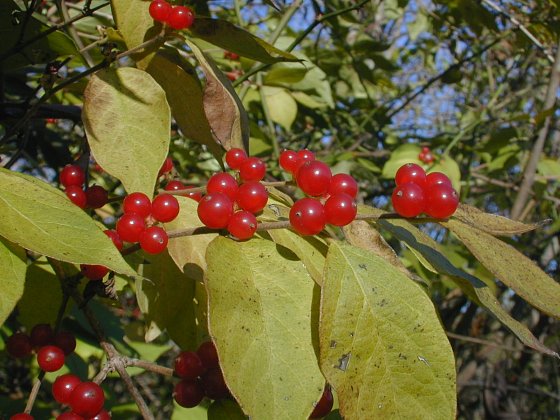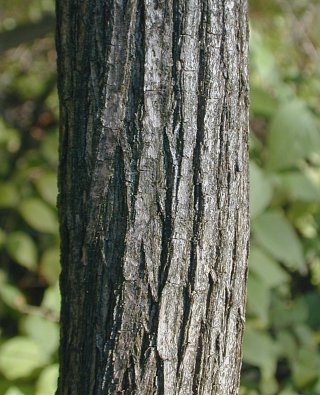Description: This shrub is up to 20' tall, 15' across, and abundantly branched. The bark of older branches is gray with flat scaly ridges and narrow grooves. Young branches and twigs are more brown, smooth-textured, and pubescent. Along the latter, pairs of opposite leaves occur. The leaf blades are 2–3½" long and 1–1½" across; they are lanceolate-ovate to ovate, smooth along the margins, and often their tips are slender and elongated. Upper surfaces of the blades are medium green and hairless, while their lower surfaces are pale green and hairless to slightly pubescent. The slender petioles are about ¼" long, light green, and slightly pubescent.

Pairs of nearly
sessile flowers develop from the axils of the leaves. Each flower is
about ¾–1" long, consisting of a tubular corolla with 5 widely
spreading lobes and a very short tubular calyx with 5 small teeth.
Initially, the corollas of young flowers are white, but they later
become cream-colored. The upper lip of the corolla is defined by 4
narrow lobes that are fused together, while the lower lip consists of a
single narrow lobe. Exerted from the corolla, there are 5 stamens with
yellow anthers and a single style with a knobby green stigma. The calyx
is light green and pubescent; directly underneath it, there is a pair
of narrowly linear bracts that soon withers away. The blooming period
occurs during late spring and lasts about 3 weeks. The fragrant flowers
are replaced by berries. At maturity, these berries are ¼" across,
globoid, shiny red, and juicy; each berry contains 2-3 seeds. The root
system is woody and branching. This shrub spreads to new areas by
reseeding itself.
Cultivation:
Amur Honeysuckle prefers full sun to light shade, moist to dry-mesic
conditions, and soil containing loam or clay-loam. It develops leaves
early in the spring and hangs on to its leaves until fairly late in the
fall. As a result, there is a strong tendency to snuff out any plants
that attempt to grow underneath it. Because this shrub spreads
aggressively, it should not be used in landscaping.

Range & Habitat:
The introduced Amur Honeysuckle is well-established in the northeast,
east-central,
and southern sections of Illinois (see Distribution
Map). This shrub undoubtedly occurs in other areas of the
state, and it is becoming more common, particularly around cities. It
is native to central and eastern Asia. Habitats include mesic deciduous
woodlands, savannas and thickets, woodland edges, power-line clearances
in wooded areas, fence rows, edges of yards, and semi-shaded waste
areas. This shrub can invade both disturbed areas and high quality
natural areas. In wooded and semi-wooded areas, it displaces native
shrubs and destroys the understory of herbaceous wildflowers.
Faunal Associations:
The nectar of the flowers attracts such visitors as bumblebees and
other long-tongued bees, Hummingbird moths (Hemaris spp.)
and other
Sphinx moths, and the Ruby-Throated Hummingbird. Some insects feed on
various parts of Amur Honeysuckle and/or other honeysuckles (Lonicera
spp.). The foliage is eaten by the caterpillars of Hemaris
thysbe (Hummingbird Clearwing), Hemaris diffinis
(Snowberry Clearwing), and miscellaneous other moths. The aphids Alphitoaphis
lonicericola, Gypsoaphis oestlundi, and Hyadaphis
foeniculi suck plant juices from honeysuckles, while the
larvae of the long-horned beetle Agrilus cyanescens
bore into the wood. Not all of these insects necessarily feed on Amur
Honeysuckle, however. The bright red berries are eaten by some
songbirds,
including the Catbird, Robin, Cardinal, Red-Wing Blackbird, Veery,
Grackles, and Yellow-Breasted Chat. This helps to spread the seeds into
new areas. Because of its abundant branches and tendency to develop
leaves early in the spring, many songbirds use Amur Honeysuckle as a
source of protective cover and as a nesting site. White-Tailed Deer
occasionally browse on the leaves and twigs.
Photographic Location:
Meadowbrook Park in Urbana, Illinois.
Comments:
This is the most aggressive honeysuckle shrub in the state of Illinois.
Amur Honeysuckle can be distinguished from similar honeysuckle shrubs
by its larger size, leaves with elongated tips, and nearly sessile
flowers and berries.